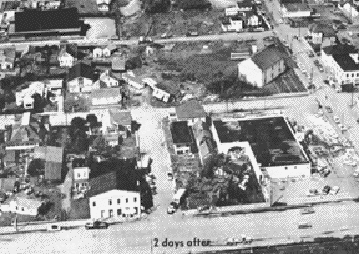What is a Tsunami?
A tsunami is a sea wave, (more precisely, a series of waves), of local or distant origin that results from large-scale seafloor displacements associated with large earthquakes, major submarine slides, or exploding volcanic islands. A tsunami can be caused by a sudden vertical movement of a large area of the sea floor during an undersea earthquake and travels at speeds in excess of 450 mph.. The first wave is almost never the largest and damaging waves may potentially arrive for hours. A tsunami is sometimes called a tidal wave, but this term is a misnomer. Unlike regular ocean tides, tsunamis are not caused by the tidal action of the moon and sun.

This diagram illustrates the difference between normal wind generated waves and tsunamis.
Image: USGS (modified)
What To Do: When you are at the beach and feel an Earthquake: A strong off-shore earthquake may generate a tsunami. Therefore, if you feel the ground shake, evacuate to high ground immediately and return only after officials say it is safe to do so.
Tsunamis along the Pacific Coast. From southern British Columbia to northern California, people and property are at risk both from distantly and locally generated tsunamis. Recent studies indicate that about a dozen earthquakes (with magnitudes of 8 or more) have occurred in the Cascadia subduction zone west of Washington. (Map) In 1946, a tsunami was initiated by an earthquake in the Aleutian Islands of Alaska; in less than 5 hours, it reached Hawaii with waves as high as 55 feet.
More recently, in 1964, a magnitude 9.2 earthquake occurred in Prince William Sound, Alaska. The shock generated a tsunami that deviated many towns along the Gulf of Alaska, and left serious damage at Alberni and Port Alberni, Canada, along the West Coast of the United States (15 killed), and in Hawaii. The maximum wave height recorded was 67 meters at Valdez Inlet. Seiche action in rivers, lakes, bayous, and protected harbors and waterways along the Gulf Coast of Louisiana and Texas caused minor damage. It was also recorded on tide gages in Cuba and Puerto Rico.
The 1964 Alaskan tsunami generated waves of more than 20 feet at Crescent City, California, where it caused $7.5 million in damage and 11 deaths. It also produced waves ranging from 10 to 16 feet along parts of the California, Oregon, and Washington coasts.

Photo: Del Norte County Historical Society
1964 Crescent City Tsunami damage estimated at $7,414,000.
The rate at which a wave loses its energy is inversely related to its wavelength. Since a tsunami has a very large wavelength, it will lose little energy as it propagates. Thus, in very deep water, a tsunami will travel at high speeds with little loss of energy. For example, when the ocean is 6100 m deep, a tsunami will travel about 890 km/hr, and thus could travel across the Pacific Ocean in less than one day. (Washington State Dept. of Resources) Tsunami wave travel-time map
Warnings When an earthquake that might generate a Pacific Coast Tsunami is detected, the
West Coast and Alaska Tsunami Warning Center and the Pacific Tsunami Warning Center calculates the danger and notifies the communities at risk. Those warnings may give people a few hours to prepare and evacuate (depending on the distance to the earthquake). If the earthquake occurs off our coast, however, there may be no time to send out hazard warnings. The first waves could arrive within minutes of the earthquake. The only tsunami warning might be the earthquake itself.